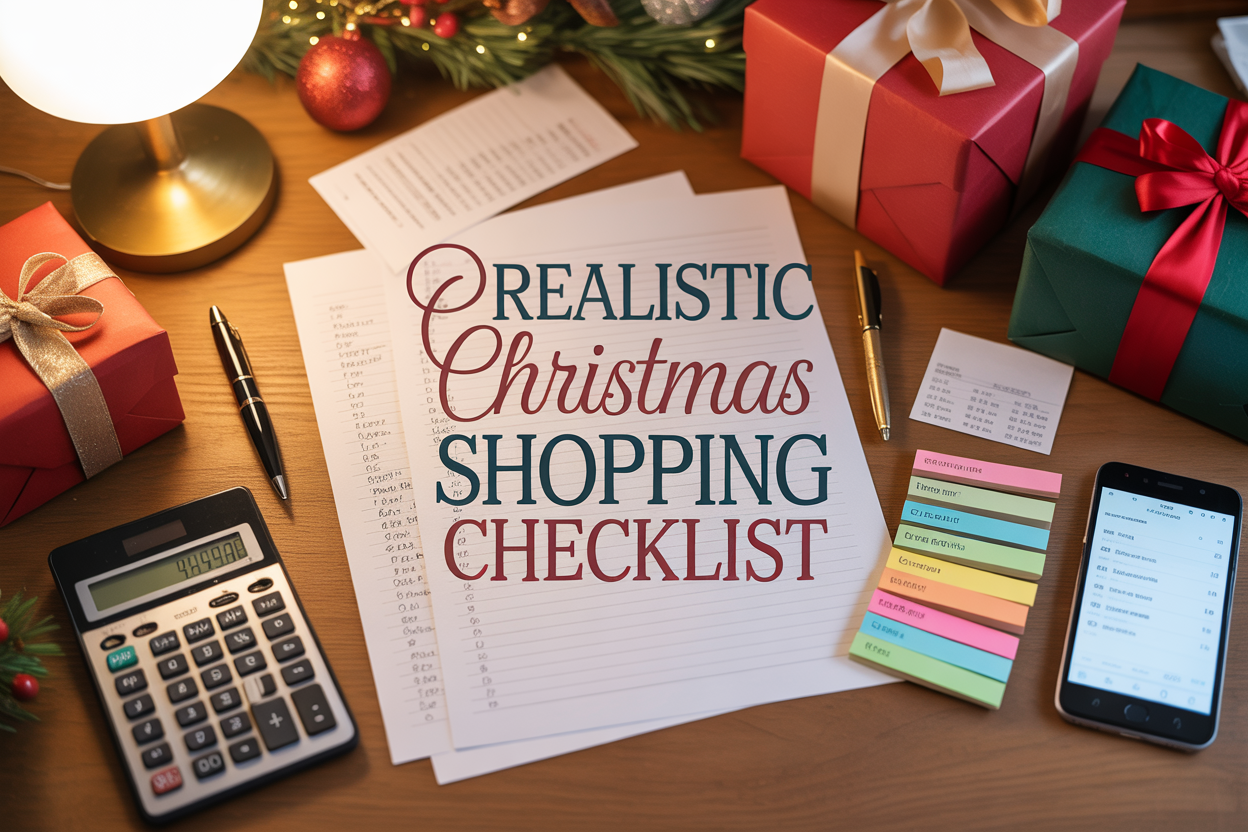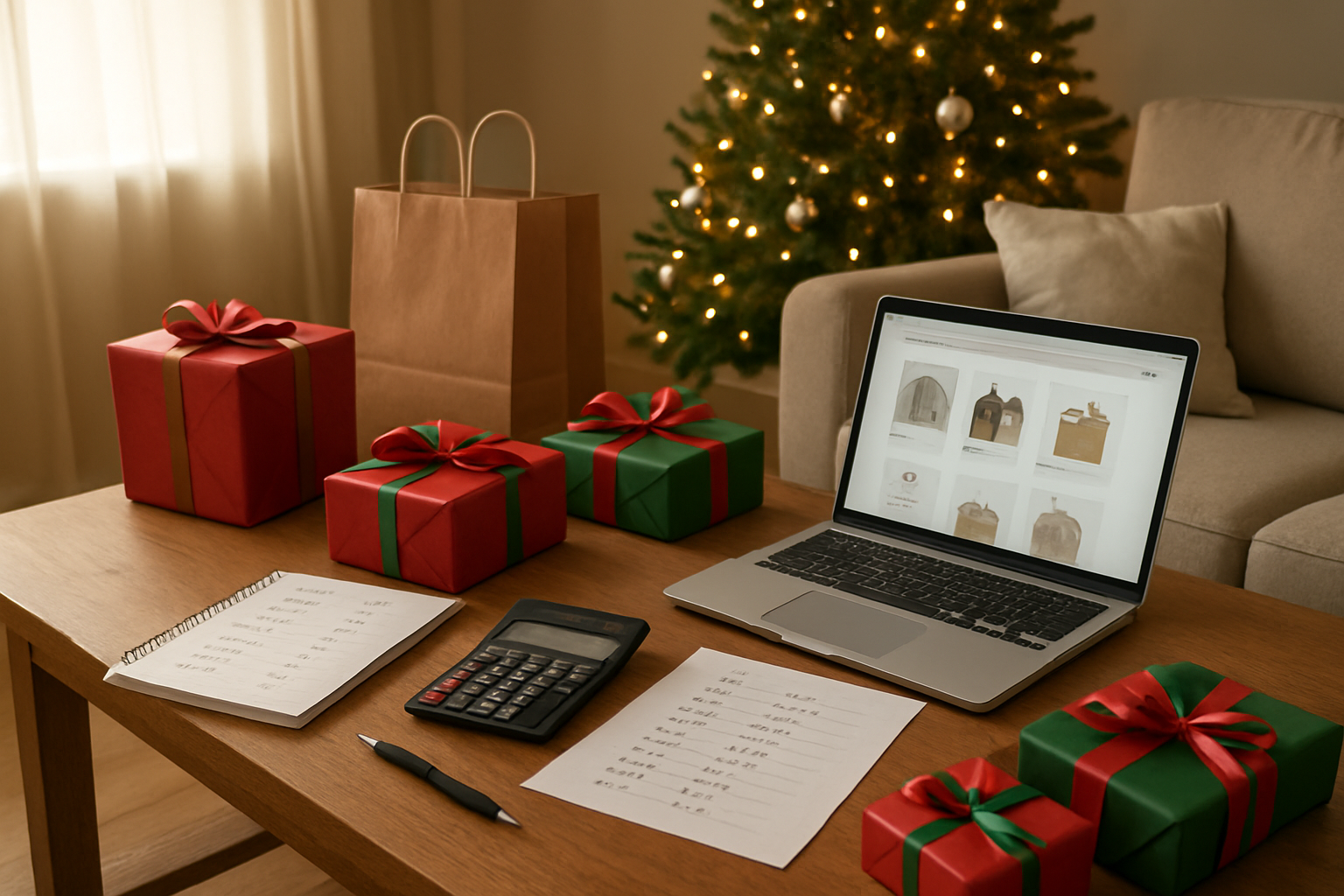THE REALISTIC CHRISTMAS SHOPPING CHECKLIST

Christmas shopping doesn't have to drain your bank account or leave you stressed out in crowded malls. This realistic Christmas shopping checklist is designed for busy families, budget-conscious shoppers, and anyone who wants to give thoughtful gifts without the financial hangover.
You'll learn how to create a Christmas budget planning system that actually works for your income, plus discover a proven holiday shopping strategy that saves both time and money. We'll also cover how to find Christmas gift ideas on budget that feel personal and meaningful, not cheap or last-minute.
By the end, you'll have a complete Christmas shopping guide that turns holiday gift-giving from a source of stress into something you can actually enjoy.
Set Your Budget Before You Start Shopping

Calculate your total available Christmas funds
Start by taking an honest look at your finances. Check your bank accounts, savings, and any money you've been setting aside throughout the year specifically for Christmas shopping. Don't forget to factor in your regular December expenses like rent, utilities, groceries, and other monthly bills. The amount left over after covering these essentials becomes your Christmas budget planning foundation.
Consider any upcoming December income too - bonuses, freelance payments, or holiday work shifts. Be conservative here though. Only count money you're absolutely certain you'll receive. Building your Christmas shopping checklist around wishful thinking leads to January credit card regret.
Allocate specific amounts per person on your list
Once you know your total budget, it's time to divide it among your gift recipients. Start with immediate family members and closest friends - they typically get the largest portions. Then work down to coworkers, neighbors, and acquaintances who might receive smaller gifts.
Write down each person's name with their allocated amount. This prevents you from accidentally overspending on one person early in your shopping and leaving others shortchanged. A simple spreadsheet or notebook works perfectly for tracking these amounts.
Sample Budget Allocation:
-
Spouse/Partner: $150
-
Children (each): $100
-
Parents (each): $75
-
Siblings (each): $50
-
Close friends (each): $30
-
Coworkers (each): $15
Include extra money for wrapping supplies and decorations
Those gift bags, wrapping paper, ribbons, and tape costs add up faster than you'd expect. Set aside 10-15% of your total gift budget for these extras. This covers not just wrapping materials but also greeting cards, gift tags, and any last-minute decorative touches that make your presents look thoughtful and polished.
If you're hosting holiday gatherings, factor in decoration costs too. Fresh garland, candles, or a few new ornaments might seem small but can strain your budget if you haven't planned for them.
Create a backup fund for unexpected gift opportunities
Keep a small emergency fund - maybe 20% of your total budget - for those surprise situations that always pop up during the holidays. Maybe your child's teacher gives them a gift and you want to reciprocate. Or you find the perfect item for someone at an incredible price but it's not in their original category.
This backup fund also covers you when you discover you've forgotten someone on your list or when a casual acquaintance unexpectedly gives you a gift. Having this cushion prevents panic purchases that blow your carefully planned Christmas shopping guide completely off track.
Make Your Gift Recipients List and Prioritize

Write down everyone you need to buy gifts for
Creating a comprehensive holiday gift list forms the foundation of your Christmas shopping strategy. Start by brainstorming everyone who typically receives a gift from you during the holidays. This includes immediate family members, extended relatives, close friends, colleagues, teachers, service providers, and anyone else who's become part of your gift-giving tradition.
Don't forget about the people who might slip your mind initially - your child's piano teacher, the mail carrier, your workout buddy, or that neighbor who always helps with packages. Write down literally everyone, even if you're unsure whether you'll actually buy them something. You can always cross names off later, but forgetting someone entirely leads to last-minute panic shopping.
Consider keeping this list in your phone or a notebook you carry regularly. As you think of additional people throughout your day-to-day activities, add them immediately. Many shoppers discover they've forgotten key people only when they're already stressed and running out of time.
Rank recipients by importance and relationship closeness
Your Christmas gift list probably contains a wide range of relationships, from your spouse and children to casual acquaintances. Creating a priority system helps you allocate both your budget and shopping energy effectively.
Start by dividing your list into three categories: Priority 1 (immediate family and closest friends), Priority 2 (extended family, good friends, and important colleagues), and Priority 3 (acquaintances, service providers, and social obligations). This Christmas shopping checklist approach ensures your most important relationships receive the attention they deserve.
Priority 1 recipients should get the most thoughtful gifts and the largest portion of your budget. These are the people who matter most to you - your children, spouse, parents, siblings, and best friends. For Priority 2, you can focus on nice but less expensive options. Priority 3 recipients often appreciate small tokens of appreciation rather than substantial gifts.
This ranking system also helps when you're running short on time or money. You can focus your energy on higher-priority recipients and scale back on lower priorities if needed.
Set realistic spending limits for each person
Once you've organized your recipients by priority, assign specific dollar amounts to each person based on your overall Christmas budget planning. Be honest about what you can actually afford - overspending on gifts creates financial stress that lingers long after the holidays end.
Create a simple spending guide that might look like this:
| Priority Level | Spending Range | Examples |
|---|---|---|
| Priority 1 | $50-$150+ | Immediate family, closest friends |
| Priority 2 | $20-$75 | Extended family, good friends |
| Priority 3 | $5-$25 | Colleagues, teachers, acquaintances |
Adjust these ranges based on your total budget and personal circumstances. A family with young children might spend more on kids and less on adults, while someone with a smaller budget might cap Priority 1 gifts at $25-$50.
Write the spending limit next to each name on your list. Having these numbers visible prevents impulse purchases and keeps you accountable to your holiday shopping strategy. When you see that perfect $80 sweater for your cousin who's in the Priority 2/$40 category, you'll remember to look for alternatives or consider moving them to a different category if the relationship truly warrants it.
Remember that meaningful Christmas presents don't always correlate with price tags. Sometimes a $15 gift chosen with care and attention means more than an expensive item bought without much thought.
Research and Plan Your Purchases Strategically

Browse online for gift ideas within your budget ranges
Start your Christmas shopping strategy by exploring gift ideas that match your predetermined budget categories. Create separate browser bookmarks or Pinterest boards for each price range - perhaps $10-25 for coworkers, $25-50 for extended family, and $50-100 for immediate family members. This approach prevents you from falling in love with expensive items that don't fit your Christmas budget planning.
Online platforms like Amazon's wish lists, Target's gift guides, and specialty retailers often organize their Christmas gift ideas by price point, making your search more efficient. Don't overlook social media platforms where influencers and brands showcase budget-friendly holiday gift options. Instagram and TikTok frequently feature creative, affordable gift compilations that can spark inspiration for your holiday gift list.
Compare prices across multiple retailers
Price comparison becomes your secret weapon for holiday shopping savings. Use comparison websites like Google Shopping, PriceGrabber, or Shopzilla to quickly scan multiple retailers for the same item. Many browsers now offer built-in price comparison tools that automatically show you where to find the best deals.
Don't forget to check both online and brick-and-mortar store prices. Sometimes online retailers offer exclusive discounts, while physical stores might have clearance items not available online. Big box stores like Target and Walmart often price-match competitors, so bring proof of lower prices from other retailers.
Create a simple spreadsheet to track prices across different stores for your most important purchases. Include columns for the retailer name, regular price, any current discounts, and estimated total cost including taxes and shipping. This Christmas shopping guide approach helps you spot genuine deals versus marketing tricks.
Check store hours and holiday shopping schedules
Holiday shopping schedules change dramatically during the Christmas season, and smart shoppers plan around these variations. Most retailers extend their hours starting in November, with many staying open until midnight during peak shopping weekends. Black Friday and the week before Christmas typically feature the longest shopping hours.
Visit retailer websites to check their holiday calendars, as many post special shopping hours weeks in advance. Some stores offer early bird shopping hours for seniors or special needs customers, which can provide a calmer shopping experience with better customer service attention.
Consider shopping during off-peak hours when possible. Tuesday through Thursday mornings usually offer the best combination of fully stocked shelves, helpful staff, and shorter checkout lines. Weekend evenings and lunch hours typically present the most crowded conditions.
Sign up for retailer newsletters to catch sales alerts
Email newsletters become your early warning system for the best holiday deals. Most major retailers send exclusive discount codes to their email subscribers, often 24-48 hours before announcing sales to the general public. This gives you a significant advantage in your Christmas shopping strategy.
Create a dedicated email folder for holiday shopping newsletters to keep your main inbox organized. Popular retailers like Target, Amazon, Best Buy, and department stores frequently send weekly roundups of their best deals, plus flash sale notifications.
Many stores also offer welcome discounts ranging from 10-20% off your first purchase just for signing up. Time these sign-ups strategically - register for newsletters from stores where you plan to make major purchases about a week before you're ready to buy. This maximizes your chances of receiving a welcome discount code you can actually use for your meaningful Christmas presents shopping.
Choose Practical and Meaningful Gift
Categories

Focus on items people actually need and use
The best practical Christmas gifts are the ones that recipients reach for again and again. Think about what your friends and family actually use in their daily routines. That cozy throw blanket for the person who's always cold, a quality water bottle for your fitness-minded friend, or nice coffee for the caffeine addict in your life.
Start by observing what people already own but might need to replace. Has your mom mentioned her old blender is acting up? Does your brother's work bag look worn out? These replacement items make excellent practical Christmas gifts because they solve real problems while showing you pay attention to their needs.
Kitchen essentials, organizational tools, and quality basics like nice towels or sheets consistently rank as favorites because people use them regularly. The key is choosing items that upgrade what they already have rather than adding clutter to their homes.
Consider experiences over material possessions
Experiences create lasting memories while avoiding the accumulation of more stuff. A cooking class for the foodie, concert tickets for the music lover, or a spa day for someone who needs relaxation often provide more joy than physical items.
Local experiences work particularly well for meaningful Christmas presents. Museum memberships, restaurant gift cards, or tickets to local events support your community while giving recipients something to look forward to. Many people prefer these types of gifts because they don't require storage space and can be shared with others.
Consider the recipient's schedule and preferences when choosing experiences. A busy parent might appreciate a house cleaning service more than tickets to an evening event, while an adventurous friend would love a rock climbing lesson or hiking trip.
Select gifts that match recipients' current interests
Your Christmas shopping guide should include recent conversations with gift recipients to understand their current hobbies and interests. Someone who just started gardening will appreciate quality tools or interesting plants more than generic gifts. A person learning to cook might love specialty ingredients or a well-regarded cookbook.
Pay attention to what people post about on social media or mention in casual conversation. These clues reveal their genuine interests better than assumptions based on past preferences. People's hobbies evolve, and staying current with their interests shows thoughtfulness.
Ask subtle questions throughout the year about what they're enjoying or wanting to try. This Christmas shopping strategy helps you give gifts that feel perfectly timed and relevant to their current life phase.
Avoid trendy items that may quickly lose appeal
Trendy gadgets and fashionable items might seem exciting, but they often end up forgotten in drawers. Instead of chasing the latest viral product or seasonal fad, stick to timeless items that maintain their usefulness and appeal.
Fast fashion accessories, novelty kitchen gadgets that serve only one purpose, and tech items with short lifecycles rarely provide lasting value. These purchases often feel wasteful once the initial excitement wears off, especially when you're following a Christmas budget planning strategy.
Classic, well-made items in neutral styles tend to age better and integrate seamlessly into people's lives. A quality leather wallet, classic watch, or well-designed organizational system will likely be appreciated years after trendy alternatives have been discarded. This approach to Christmas gift ideas on budget ensures your money goes toward purchases that truly enhance the recipient's life rather than creating temporary excitement.
Time Your Shopping for Maximum Savings

Take Advantage of Black Friday and Cyber Monday Deals
Black Friday and Cyber Monday remain the gold standard for holiday shopping savings, with retailers offering their deepest discounts of the year. Start preparing weeks ahead by creating wish lists on retailer websites and downloading their apps to receive exclusive notifications about flash sales and early-bird specials.
Most major retailers release their Black Friday ads in early November, giving you time to compare prices and map out your shopping strategy. Don't limit yourself to traditional brick-and-mortar stores – online retailers often match or exceed in-store deals, and you can avoid the crowds while still snagging impressive discounts.
The key is staying organized during these high-energy shopping days. Keep your Christmas shopping checklist handy and stick to items that genuinely match your recipients' interests. Many shoppers get caught up in "deal fever" and purchase items simply because they're discounted, which defeats the purpose of smart holiday shopping strategy.
Sign up for cashback apps and browser extensions that automatically apply coupon codes. These tools can stack savings on top of already reduced Black Friday prices, maximizing your Christmas budget planning efforts.
Shop Early December for Best Selection and Moderate Prices
Early December offers the perfect sweet spot between selection and savings. While you won't find the rock-bottom prices of Black Friday, retailers still offer competitive discounts ranging from 20-40% off regular prices. More importantly, you'll have access to full inventory before popular items sell out.
This timing works exceptionally well for practical Christmas gifts like clothing, electronics, and home goods. Retailers know shoppers are getting serious about their holiday gift list, so they maintain attractive pricing to capture market share before the final shopping rush begins.
Shopping during the first two weeks of December also gives you breathing room for shipping delays or the need to exchange items. You can take advantage of free shipping promotions that typically require 5-7 business days for delivery, ensuring your presents arrive on time.
Consider this period ideal for purchasing items that require personalization or special ordering. Custom jewelry, monogrammed accessories, and made-to-order items need processing time, making early December shopping essential for these meaningful Christmas presents.
Use Last-Minute Clearance Sales for Gift Cards and Accessories
The week leading up to Christmas brings desperate retailers slashing prices on remaining inventory. While selection becomes limited, this creates perfect opportunities for purchasing gift cards, stocking stuffers, and accessories that complement your main presents.
Department stores often discount gift cards by 10-20% during final shopping days, essentially giving you free money for future purchases. These make excellent additions to your main gifts or standalone presents for coworkers and extended family members on your Christmas shopping checklist.
Accessories like scarves, jewelry, tech cases, and small electronics frequently see steep markdowns as stores clear inventory for post-holiday merchandise. These items work perfectly as thoughtful additions to larger gifts or standalone presents when you discover someone new on your list.
Don't overlook clearance sections in grocery stores and pharmacies, which often stock holiday-themed items, gourmet foods, and personal care gift sets at significantly reduced prices. These locations provide budget-friendly options for last-minute additions to your Christmas shopping guide without breaking your established spending limits.
Remember that last-minute shopping requires flexibility in your expectations. Focus on the gesture rather than finding the "perfect" item, and you'll discover plenty of meaningful options even in those final shopping days.

Managing Christmas shopping doesn't have to turn into a financial nightmare or last-minute panic. By setting a clear budget upfront, making a prioritized list of recipients, and timing your purchases right, you'll stay organized and avoid overspending. The key is being strategic about what you buy and focusing on gifts that actually matter to the people you care about.
Start planning now rather than waiting until December rolls around. Your wallet will thank you, your stress levels will stay manageable, and you'll actually enjoy the holiday season instead of dreading it. Smart shopping means more time for what Christmas is really about – spending quality moments with family and friends.
Comments
Post a Comment